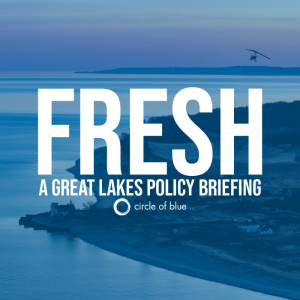Federal Water Tap, November 27: Army Corps Signs Agreement for Solar Panels above Tribe’s Irrigation Canal
The Rundown
- EPA publishes draft guidance for groundwater pollution regulation enabled by a 2020 U.S Supreme Court decision.
- A Department of Energy lab reports on the state of the U.S. hydropower market.
- EPA watchdog announces new investigations into underground injection wells and funding for removing lead drinking water pipes.
- National Weather Service intends to study public response to flood forecast messaging.
- EPA opens the application period for $2 billion in climate resilience funding for environmental justice communities.
- This week, the Defense Department holds an energy and environment conference.
And lastly, the Army Corps signs an agreement with the Gila River Indian Community for a project to place solar panels over an irrigation canal.
“[This] is incredibly innovative work – clean energy, water conservation.” — Michael Connor, head of the Army Corps of Engineers, speaking on X after a signing ceremony for an agreement to put solar panels over an irrigation canal through the Gila River Indian Community, in central Arizona. Solar panels, which will reduce evaporation while generating power, will be placed above 1,000 feet of the tribe’s I-10 Level Top canal, the Arizona Mirror reports. The $6.7 million project, one of the first in the country, is expected to be completed in 2025. A pilot project in California is placing solar panels above 8,500 feet of canals in Turlock Irrigation District.
In context: Solar Panels on Water Canals Seem Like a No-Brainer. So Why Aren’t They Widespread?
By the Numbers
$2 Billion: Grant funding available for disadvantaged communities for preventing pollution, adapting to climate change, and building green infrastructure. Administered by the EPA, the funds are part of the Inflation Reduction Act. Applications are being accepted for a year — through November 21, 2024.
News Briefs
Regulating Groundwater Pollution
The U.S. Supreme Court’s Maui decision, in 2020, opened the door for some groundwater pollution to be regulated under the Clean Water Act.
The EPA wants public comments on draft guidance for implementing the court’s decision, which was vague about what counts as a regulated pollution discharge to groundwater.
The decision authorizes agencies to require pollution permits when pollutants from a “point source” are dumped in groundwater that connects to a regulated river, lake, or ocean. Point sources, generally speaking, come from a pipe.
The EPA, in its draft guidance, acknowledges that determining a regulated discharge will be “highly dependent on site-specific considerations.” Some of those considerations: how long the pollutants take to reach a regulated surface water and how far they travel.
Comments are due December 27 and should be submitted via www.regulations.gov using docket number EPA–HQ–OW–2023–0551.
Studies and Reports
U.S. Hydropower Market Report
The U.S. hydropower sector is growing by adding generating capacity at dams that do not have turbines and by building a form of hydropower that functions as a battery.
That’s according to a market report from Oak Ridge National Laboratory.
At the end of 2022, the report identified 117 new hydropower facilities in development, from permitting and design to construction. That’s down from 219 facilities at the end of 2019.
Growth, on the other hand, is happening for pumped storage proposals. These facilities are a way to store surplus electricity generated by wind and solar. Water is pumped to an upper reservoir when there is abundant electricity and released to a lower reservoir when the power is needed.
At the end of 2022, 96 pumped storage projects are in development, up from 67 three years earlier.
In context: U.S. Hydropower Grows By Going Small
How Does the Public Understand Flood Risk Messaging?
The National Weather Services’ behavioral sciences branch will study how the public and emergency responders understand and respond to the agency’s flood forecasts. The conclusions will help design better public communications about flood risk.
The survey will be conducted in Roanoke, Virginia, and Greenbrier County, West Virginia.
On the Radar
Defense Department Environment Conference
From November 28 to December 1, the Defense Department will hold its Energy and Environment Innovation Symposium, in Arlington, Virginia.
The agenda includes PFAS toxicity, climate resilience, water security for military bases, sea-level rise, groundwater treatment, and invasive species.
EPA Watchdog Investigations
The EPA Office of the Inspector General announced two new investigations.
One will look at the agency’s management of Class VI underground injection wells. These are wells used as subsurface garbage cans for carbon dioxide and are an integral part of carbon capture and sequestration.
The other investigation will assess the agency’s allocation of infrastructure funds for removing lead drinking water pipes.
Federal Water Tap is a weekly digest spotting trends in U.S. government water policy. To get more water news, follow Circle of Blue on Twitter and sign up for our newsletter.
Brett writes about agriculture, energy, infrastructure, and the politics and economics of water in the United States. He also writes the Federal Water Tap, Circle of Blue’s weekly digest of U.S. government water news. He is the winner of two Society of Environmental Journalists reporting awards, one of the top honors in American environmental journalism: first place for explanatory reporting for a series on septic system pollution in the United States(2016) and third place for beat reporting in a small market (2014). He received the Sierra Club’s Distinguished Service Award in 2018. Brett lives in Seattle, where he hikes the mountains and bakes pies. Contact Brett Walton







Leave a Reply
Want to join the discussion?Feel free to contribute!